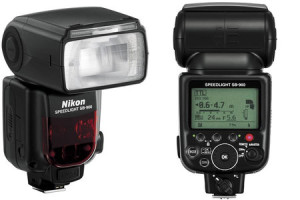One of the easiest ways to dramatically improve your outdoor photography is to use fill flash. I recommend this as a beginning photographer’s first step into turning pro because it’s easy to learn and the results can be amazing.
There are various ways of filling in shadows for outdoor photography such as bounce cards, reflector boards, or using natural surroundings such as walls or rock formations to reflect the sunlight onto your model. I will cover those in later articles. For now, let’s focus on using speed lights or ‘flash’ to manipulate the light.
Reflector board bounces natural light onto the model:
There are various speed lights you can use and I won’t go into product reviews here but I use the Nikon SB-900:
This normally mounts on the camera’s hot shoe but to dramatically improve your photos, you’ll want to have it off your camera and be able to fire it remotely so you can have the flash at opposite angles from your camera.
In this example, the sunlight is 90° to camera right (as evidenced by the shadows to the left of her boots) and my fill flash is at 60° to camera left.
There are three ways to fire a flash remotely:
1. Built in capability
2. Infrared transmitter/receiver
3. Radio transmitter/receiver
Some cameras come with built-in capability to fire a flash remotely (such as Nikon or Canon) but the problem is that they usually use infrared technology to transmit the signal. Infrared is not reliable outdoors, has limited range, and relies on line of sight. When photographing a model – particularly outdoors – you want your flash and camera to work every time with no delays. For this reason, I recommend spending the extra money and getting a radio transmitter/receiver to fire your off camera flash. With good batteries, it will fire consistently and reliably every time even in full sunlight and blocked line of sight.
I currently use the Paul Buff Cyber Commander and CyberSync receivers.
The Cyber Commander mounts on your camera’s hot shoe and transmits the signal to fire when you press the shutter to take a picture.
And the CyberSync receivers get the signal to fire and send it to the attached speed light.
Note that you won’t be able to adjust the intensity of the flash from your camera or the transmitting unit using this set up. Instead, set your flash to manual and adjust the intensity on the speed light’s controls. The SB-900 varies from 1/1 to 1/64 power.
Now that you have your speed lights working remotely via radio and have tested them, let’s take them out in the field.






